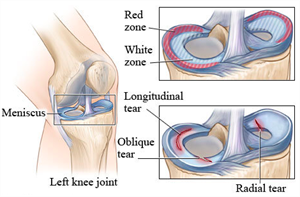What are they?
The meniscus is a fibrocartilaginous tissue which sits in the knee joint between the tibia (shin bone) and the femur (thigh bone). There are 2 in each knee joint and they are moon shaped (C shaped). Their job is to help with the shock absorption in the knee and to disperse friction.
How do they get injured?
Meniscal tears either occur by a trauma or sports injury or due to chronic overloading and degeneration. The mechanism of injury for acute tears is normally a twisting motion with a bent knee. We see these injuries commonly in sports such as netball, rugby, football and any other sport which requires dynamic loading of the legs with sudden changes of direction.
What does it feel like?
Acute meniscal tears are immediately painful. You might notice some swelling around the joint line, pain, local tenderness and may feel a popping or clicking sensation in the knee. Commonly patients complain of a locking of the knee joint or the inability to fully straighten the knee. This is due to a piece of the torn meniscus taking up some of the space in the knee joint.
How is it diagnosed?
Your physiotherapist can diagnose a meniscal injury by listening to the mechanism of injury, the amount of time it took to swell, and by performing some simple tests. If we suspect a meniscal injury and things aren’t progressing as we would expect. We will refer you to a specialist for further investigations such as (MRI) to confirm the injury. If you have a torn meniscus which is not responding to physiotherapy you may be recommended a surgical procedure.
How can Back In Action help?
One of the most common symptoms of a meniscal injury is loss of full movement and strength in your affected leg. We initially work to regain your range of movement with hands on techniques. Such as mobilisations, massage and taping and help to maintain and build strength in your leg. You will probably find it difficult to walk on your leg so we will work on getting you back on your feet. We can discuss options with you including conservative rehabilitation and/ or surgery. Strengthening your knee before surgery is also important to ensure the best post- operative outcome.

